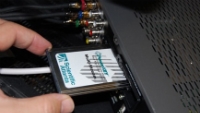FCC admits CableCARD is a failure

RIP CableCARD. After almost a decade of experimentation, the FCC is finally giving up on CableCARD, the effort that began with the Telecommunications Act of 1996 in trying to open up cable systems from proprietary copy protection technology.
CableCARD was the government’s attempt to open up the “navigation” market for video content, allowing third-party televisions, DVRs and set-top boxes to access and control cable video streams. It was supposed to solve the problem, but it was slow to deploy, was never widely supported and had huge limitations. Early versions of the host spec supported only one-way access, so electronic program guides, video-on-demand and other two-way services didn’t function.
Third-party CableCARD devices, in the form of PC-style plug-in cards, first became available in 2004. Today, there are only 14 third-party certified devices that aren’t directly controlled by the cable companies.
The FCC wants ideas for a new set of rules that will open access to video streams from cable and IPTV operators.
Get the TV Tech Newsletter
The professional video industry's #1 source for news, trends and product and tech information. Sign up below.
